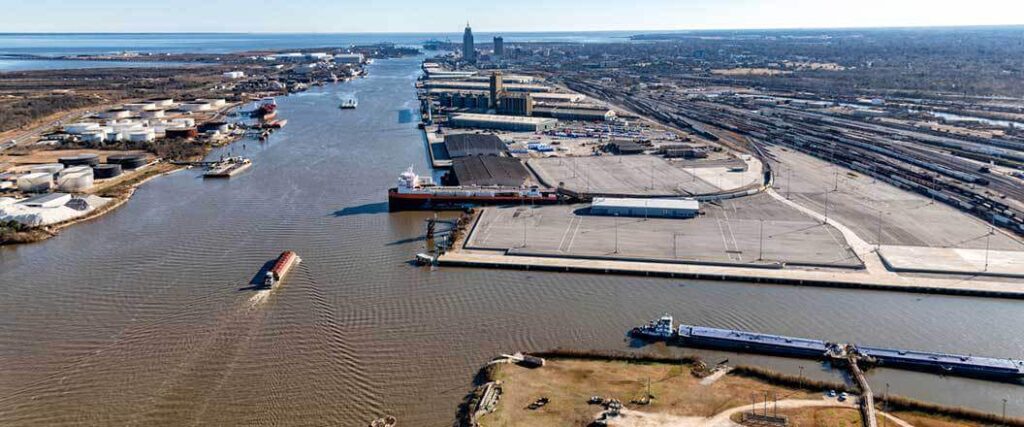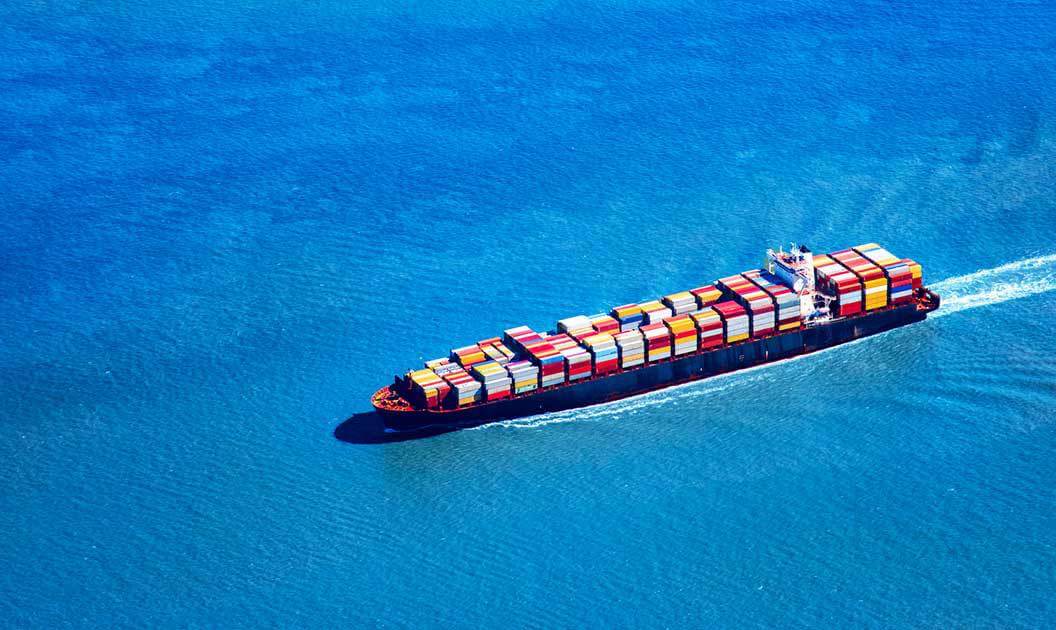Gulf coast transload services have been on the rise as more and more businesses are moving their import and export services away from the congested and often cost-prohibitive west coast ports. In recent years, transload facilities along the Gulf Coast have been seeing more business as local manufacturers and other industries take advantage of expanding ports and renewed rail services.
Transload facilities along the Gulf Coast are located near many of the major ports and railyards that stretch from Florida’s Sun Coast ports in Tampa and St. Petersburg to the Port of Corpus Christi in Texas. Gulf Coast transload facilities are capable of handling a variety of commodities from bulk crude oil to palletized goods.
Explore new ways to move your goods within the United States and to places beyond.

Gulf Coast Transload: Enter a Growing Market
The ability to ship goods throughout the continental United States and with our Southern and Northern trading partners has become very challenging. On top of seeking ways to streamline shipping and distribution in general, some are looking for new markets in high-growth areas.
If you are one of the many importers seeking to bypass the San Pedro ports, the Gulf Coast ports and related services have seen major expansions in recent years. Even if you are not looking to completely stop shipping into the west, ports in the Gulf still offer an excellent opportunity to diversify your market base.

Benefits of Gulf Port Transloading Services
For importers, drayage and transload services tend to go hand in hand. Once seen as the key to alleviating congested ports by providing transport to warehouses away from the port, rising fuel costs are making this less profitable.
The problem is that areas such as Los Angeles simply have no closer facilities available. This is where Gulf Coast transloading services can be of greater benefit.
Lower Industrial Rent Rates
By using distribution warehouses closer to the ports, many hope to save on shipping and the inevitable fuel surcharges now being added on for many deliveries. While a good strategy for savings, it relies on there being available and well-priced industrial space available.
When it comes to California and its famous Inland Empire, this may not even be possible. Industrial warehousing along the Gulf is both more available and has not reached the same price heights.
Average Rental Price of Industrial Property in 2021
| Area/Region | Annual Price Per Sq foot |
| Los Angeles, California | $15.51 |
| Inland Empire, California | $12.84 |
| Austin, Texas | $11.07 |
| Orlando, Florida | $7.99 |
| San Antonio, Texas | $6.74 |
| Tampa, Florida | $6.72 |
| Houston, Texas | $5.16 |
Houston and Tampa are both port cities where the annual rent for warehouse space per square foot is going for less than half of their West Coast counterpart in California. While prices will fluctuate depending on warehouse services, there is still a significant price difference. You could not only be saving on warehouse space but on drayage services as well.
This would allow you to take full advantage of available transload services in those markets. Even if you decide to move further away from the coast, such as Austin, TX, or Orlando, FL, you are still centrally located within those states to be able to distribute to a large area and population.

Access to Inland Waterways
Gulf Coast transloading services also offer another unique option to get goods both in and out of the U.S. - access to the Mississippi River. According to the U.S. Department of Transportation’s Bureau of Transportation Statistics, more than 500 million short tons of cargo were transported using Mississippi River waterways in 2019, a figure that has only grown since then.
When most think of transload services, the most frequent uses tend to be from container to overland truck, container to railcar, or vice versa. If you are bringing in your goods through major West or East Coast ports, those tend to be the only options. The Gulf is another matter.
There are three major ports with ease of access to the Mississippi River and its barge transport freight system.
- Port of Baton Rouge, Louisiana
- Port of New Orleans, Louisiana
- Port of Gulfport, Mississippi
Ports that are slightly further away but may still be viable options include the Port of Houston in Texas and the Port of Mobile in Alabama.
Currently, there is a variety of major commodities regularly shipped up and down the Mississippi River, and even talks of expanding ports outside of St. Louis to handle specially designed container ships.
Common bulk materials needing transloading include:
- Petroleum
- Coal
- Coke
- Iron
- Gravel
- Chemicals
By taking advantage of transloading services that bring your goods to and from the Mississippi River, you gain access to a central waterway that passes through some major river port cities in the midwest.
These include:
- St. Louis, Missouri: This city is known both for its advanced manufacturing capabilities and as a central location for nationwide distribution services.
- Memphis, Tennessee: Recent growth and the location of a newly built major automotive plant make this one of the fastest-growing economic areas in the U.S.
Gaining access to inland waterways also serves to limit how often your products are being transferred. While fuel prices are still a factor, you would still be able to transload a significantly greater amount of goods to a river barge than to a dry van trailer or even railcar.
For businesses shipping goods in and out of Mexico, ocean transload services can also move commodities onto barges that can travel through canals and waterways there. If you want to avoid container ships and overland trucks completely, you can transload materials to barges that stay within the Gulf and travel directly to major ports in Texas and Florida.
Mexican ports offering viable opportunities for transload services include:
- Tampico
- Altamira
- Tuxpan
- Veracruz
- Puerto Progreso
Tight truck and rail capacities mean there is fierce competition to get your cargo out of the country. A barge can usually make the trip from Mexico to Florida in three days, whereas an overland truck could take a week or more and cost you significantly more in fuel surcharges. Transload services in the Tampa Bay area then provide access to the entire state.

What Are the Best Gulf Ports for Imports and Exports?
Another advantage of using Gulf ports is the better balance of import and export numbers which improves port use rates overall. While you may get great export rates out of Los Angeles, getting your goods there is a struggle. Meanwhile, the terminal lease rates are nearly double compared to other ports. These are costs that a carrier will need to pass on to you.
Location and rate-wise, Gulf Coast ports working in combination with nearby transloading facilities can offer businesses a very good deal.
Gulf ports that showed the greatest growth in terms of import and export capability were:
- Port Freeport, TX
- Port of New Orleans, LA
- Port of Houston, TX
- Port of Mobile, AL
- Port Manatee, FL
- Port Tampa Bay, FL
Of the top 50 manufacturing centers in the U.S., 39 are located in the South and Midwest Regions. Shipping products to California from these areas is both time-consuming and expensive whether you are using truckload shipping or rail.
On the other hand, these centers are located relatively close to the Gulf and businesses can take advantage of a vastly more developed rail network. Significant population growth in these areas means there is also a greater chance of transloading products from shipping containers directly to retailers rather than sending them to a distribution center.
These ports are also ideally located to handle imports and exports with Mexico and Central America. Efficient turnaround times mean that containers get back and forth between nations more easily.

Combine Gulf Coast Transload With Intermodal Services
Railway services in the eastern half of the U.S. are considerably more expansive than those servicing major West Coast ports.
Looking at a map of just the major freight rail lines will show you there are nearly double the number of major freight lines directly connected to Gulf Coast ports versus West Coast ports.
These lines provide access to some of the most densely populated areas of the U.S. and the ability to directly ship to and from Mexico and Canada. Combining transload and intermodal services gives you the best of both worlds.
Exporters have more avenues to get goods sent to whichever port best suits their business or even multiple ports that can allow for market diversification. Vessels leaving the Gulf can stop in Mexico or other Central American ports of call before crossing the Panama Canal and continuing west.
For importers or domestic growers bringing merchandise into states like Florida, rail lines allow for goods to travel their length much faster than they could by truck. If you are transloading perishables, such as fruits and vegetables, the last thing you want is to have millions of dollars worth of produce go bad because you couldn’t find a trucker willing to head down the length of the peninsula.

Find Your Shipping Partners with Transload Services USA
If you are looking to make a port switch, Transload Services USA can provide your business with Gulf Coast transload options. Whatever your imports or exports are, we have industry experts on hand to transload them and keep your goods moving.
From gas to grains, Transload Services USA is there to provide reliable and trustworthy services at vetted and safe facilities. Need help with other services, domestic or otherwise?
Find a provider in your area that can help you with:
Give us a call today at (352) 282-4588 to speak with a representative. Get an online services quote and get your goods moving.

